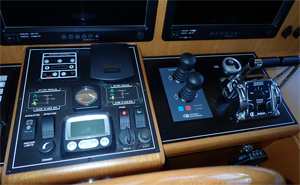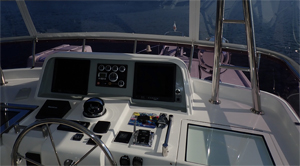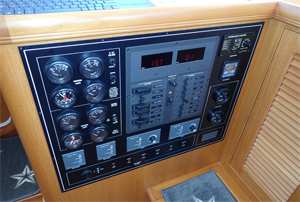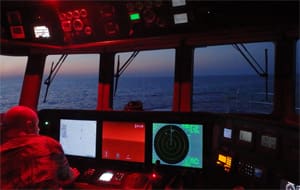Watch-standing is a shared responsibility with all who take the helm. The safety of the crew and the security of the vessel need to be your priority. Remember, some very small decisions you make can have large consequences.
When I teach power cruising offshore classes, I have summarized the duty of the watch stander simply as this: Make sure you have water under the keel, and don’t hit anything. While this is true, there are obviously many other aspects and details to consider.
Prior to leaving the dock, I like to meet with the crew to go over our intended trip, time, distance offshore, expectations, etc., and set up the watch schedule. Expectations and responsibilities need to be clearly understood, and it is wise to do an orientation and review so each crewmember is comfortable. I have a form I print out and fill in the skipper names for each time slot and then post that in the galley (it won’t be missed if you tape it to the refrigerator). During the day, there always needs to be one person who has the helm and is the designated skipper, but typically the schedule allows for overlaps and conversation. Running at night, however, you are typically on your own. Shifts at night can be lonely, which makes them feel like time is slowing down and stretching out. I suggest you break up the assignments so that no crewmember has a solo watch that exceeds three or four hours.
 |
 |
|
|
Left, a tidy instrument cluster on a Selene 59. Right, make sure you get checked out on all the gear before it’s time to stand watch. |
||
Personally, I like to prepare for my watch well in advance so that I arrive 10 to 15 minutes ahead of when my shift is scheduled to begin. Make sure you have a timed alarm set so you don’t oversleep or forget; the person who is completing their shift is really looking forward to seeing you and turning over command.
What you should actually monitor in the pilothouse and look for in the engine room to make sure everything works is a separate, more in-depth discussion perhaps for another time. I like to keep track of the details by recording data hourly in two different logs: one a paper trail “Underway Log” in the pilothouse (that includes penciling in positions on the paper charts), and the other an “Engine Room Inspection” spreadsheet on a clipboard in the engine room.
Start in the engine room
My preference is for the oncoming watch stander to “wake up” and get into the game by starting in the machinery spaces, reviewing equipment and completing that checklist by filling in the details before reporting to the pilothouse. During the day it is easier to conduct engine room checks more regularly on the hour, but at night I spread this out and like to require an engine room check once per watch and have it completed before taking the helm. If you are the only one awake and running the ship in the pilothouse, it is very difficult to leave that station for much longer than a quick head break; you typically do not have enough time to also visit the engine room.
Arrive light (visit the head), refreshed (snack and drink) and ready to be in charge. The duty of staying on course and keeping everything running smoothly should be enough to keep you occupied. Some people bring minimally distracting entertainment like pencil puzzles and music, but it’s too easy to miss out on something important if you are reading a book or watching a movie — you really need to keep your personal visual and audio “antenna” in full receiving mode. The off-watch crew has checked out and put their trust in you, so don’t let them down.
When I come on watch, I like to first debrief with the current watch stander to learn where surrounding vessel traffic is located, what the weather is doing and how the ship’s systems are operating. There should be a few minutes of time spent reviewing this information. Confirm the speed and heading of nearby targets on the radar (are they approaching or did they pass?). Understand the course (time and distance to the next waypoint) and the nav/com (are you a “course up” or a “North up” plotter?). And, review any mechanical concerns (a rogue vibration, oil leak on the generator, etc.) to ensure a smooth handover takes place.
 |
 |
|
|
Left, most flybridges have a duplicate set of instruments and controls. Right, be sure to check electrical consumption and breakers. |
||
Gauge check
My first task once settled is to scan all of the displays to view their current status. When the pilothouse is “dialed-in,” I am looking for reference lines on analog gauges to show that the needle is where it is supposed to be on temperatures and pressures. Confirm the voltage and amperage displays on the electrical panel — are the appropriate breakers on or off? At night it is easy to point the flashlight at one display at a time to mentally check them off.
I’ll be reviewing the watchstanding points in the accompanying sidebar in much more detail in 2019 when I present my “Offshore Essentials” course at each TrawlerFest venue. I hope you can attend! If you would like a copy of my three- and four-person watch-standing schedule, please send me an email and include “JMYS Watch Standing Schedule” in the subject line.
Jeff Merrill, CPYB, is the president of Jeff Merrill Yacht Sales, Inc.- www.JMYS.com. He is a veteran yacht broker who provides individual attention and worldwide professional representation to buyers and sellers of premium brand, oceangoing trawlers. Merrill is active in the cruising community as a public speaker and writer and enjoys spending time at sea with clients. Jeff has written several articles for Ocean Navigator’s Power Voyaging column and is constantly looking for new ideas to improve and simplify the trawler lifestyle. If you have a suggestion or want to get in touch, please email Merrill at Jeff.Merrill@JMYS.com.

